2016 NISSAN MAXIMA tire pressure
[x] Cancel search: tire pressurePage 55 of 97
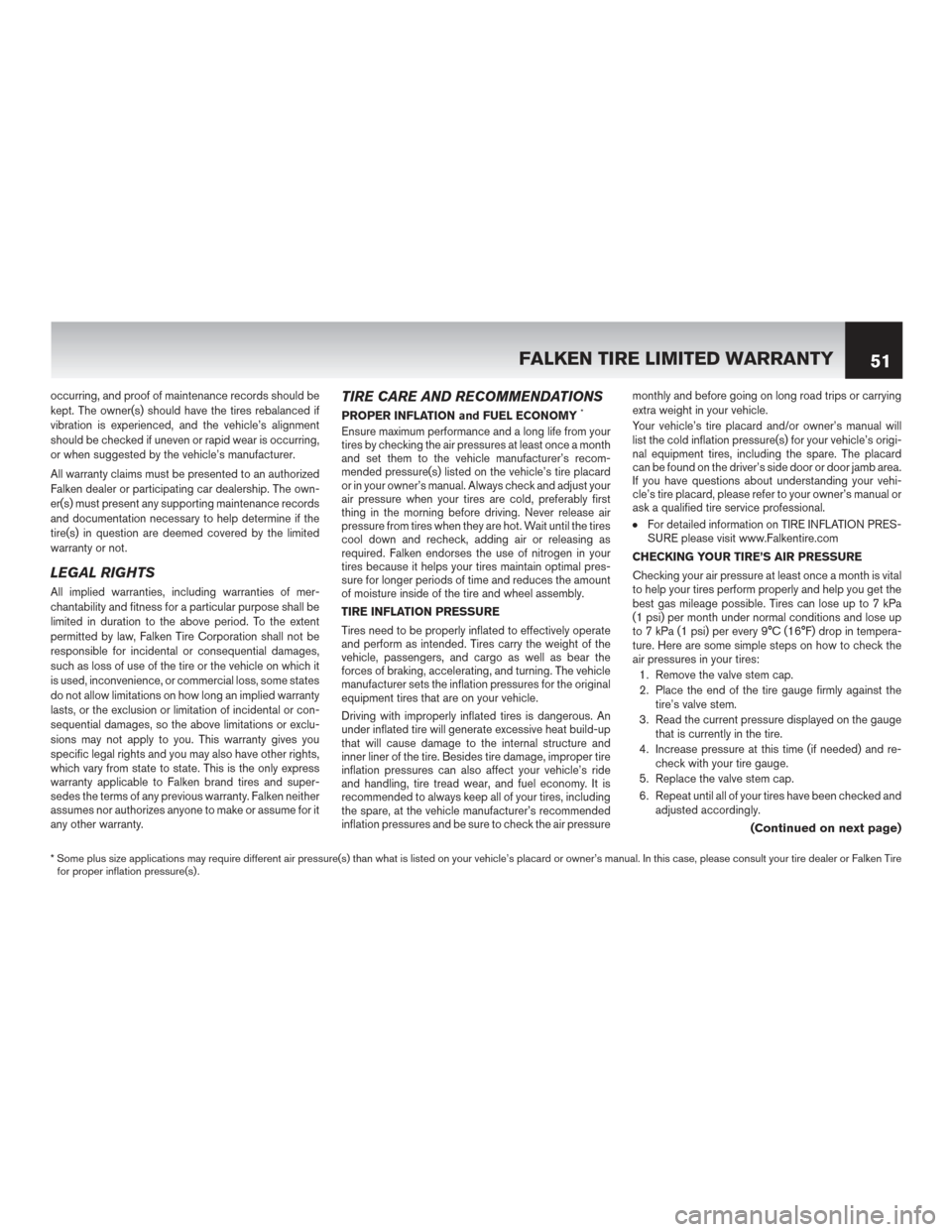
occurring, and proof of maintenance records should be
kept. The owner(s) should have the tires rebalanced if
vibration is experienced, and the vehicle’s alignment
should be checked if uneven or rapid wear is occurring,
or when suggested by the vehicle’s manufacturer.
All warranty claims must be presented to an authorized
Falken dealer or participating car dealership. The own-
er(s) must present any supporting maintenance records
and documentation necessary to help determine if the
tire(s) in question are deemed covered by the limited
warranty or not.
LEGAL RIGHTS
All implied warranties, including warranties of mer-
chantability and fitness for a particular purpose shall be
limited in duration to the above period. To the extent
permitted by law, Falken Tire Corporation shall not be
responsible for incidental or consequential damages,
such as loss of use of the tire or the vehicle on which it
is used, inconvenience, or commercial loss, some states
do not allow limitations on how long an implied warranty
lasts, or the exclusion or limitation of incidental or con-
sequential damages, so the above limitations or exclu-
sions may not apply to you. This warranty gives you
specific legal rights and you may also have other rights,
which vary from state to state. This is the only express
warranty applicable to Falken brand tires and super-
sedes the terms of any previous warranty. Falken neither
assumes nor authorizes anyone to make or assume for it
any other warranty.
TIRE CARE AND RECOMMENDATIONS
PROPER INFLATION and FUEL ECONOMY*
Ensure maximum performance and a long life from your
tires by checking the air pressures at least once a month
and set them to the vehicle manufacturer’s recom-
mended pressure(s) listed on the vehicle’s tire placard
or in your owner’s manual. Always check and adjust your
air pressure when your tires are cold, preferably first
thing in the morning before driving. Never release air
pressure from tires when they are hot. Wait until the tires
cool down and recheck, adding air or releasing as
required. Falken endorses the use of nitrogen in your
tires because it helps your tires maintain optimal pres-
sure for longer periods of time and reduces the amount
of moisture inside of the tire and wheel assembly.
TIRE INFLATION PRESSURE
Tires need to be properly inflated to effectively operate
and perform as intended. Tires carry the weight of the
vehicle, passengers, and cargo as well as bear the
forces of braking, accelerating, and turning. The vehicle
manufacturer sets the inflation pressures for the original
equipment tires that are on your vehicle.
Driving with improperly inflated tires is dangerous. An
under inflated tire will generate excessive heat build-up
that will cause damage to the internal structure and
inner liner of the tire. Besides tire damage, improper tire
inflation pressures can also affect your vehicle’s ride
and handling, tire tread wear, and fuel economy. It is
recommended to always keep all of your tires, including
the spare, at the vehicle manufacturer’s recommended
inflation pressures and be sure to check the air pressuremonthly and before going on long road trips or carrying
extra weight in your vehicle.
Your vehicle’s tire placard and/or owner’s manual will
list the cold inflation pressure(s) for your vehicle’s origi-
nal equipment tires, including the spare. The placard
can be found on the driver’s side door or door jamb area.
If you have questions about understanding your vehi-
cle’s tire placard, please refer to your owner’s manual or
ask a qualified tire service professional.
●For detailed information on TIRE INFLATION PRES-
SURE please visit www.Falkentire.com
CHECKING YOUR TIRE’S AIR PRESSURE
Checking your air pressure at least once a month is vital
to help your tires perform properly and help you get the
best gas mileage possible. Tires can lose up to 7 kPa
(1 psi) per month under normal conditions and lose up
to 7 kPa (1 psi) per every 9°C (16°F) drop in tempera-
ture. Here are some simple steps on how to check the
air pressures in your tires: 1. Remove the valve stem cap.
2. Place the end of the tire gauge firmly against the tire’s valve stem.
3. Read the current pressure displayed on the gauge that is currently in the tire.
4. Increase pressure at this time (if needed) and re- check with your tire gauge.
5. Replace the valve stem cap.
6. Repeat until all of your tires have been checked and adjusted accordingly.
(Continued on next page)
* Some plus size applications may require different air pressure(s) than what is listed on your vehicle’s placard or owner’s manual. In this case, please consult your tire dealer or Falken Tire
for proper inflation pressure(s) .
FALKEN TIRE LIMITED WARRANTY 51
Page 57 of 97
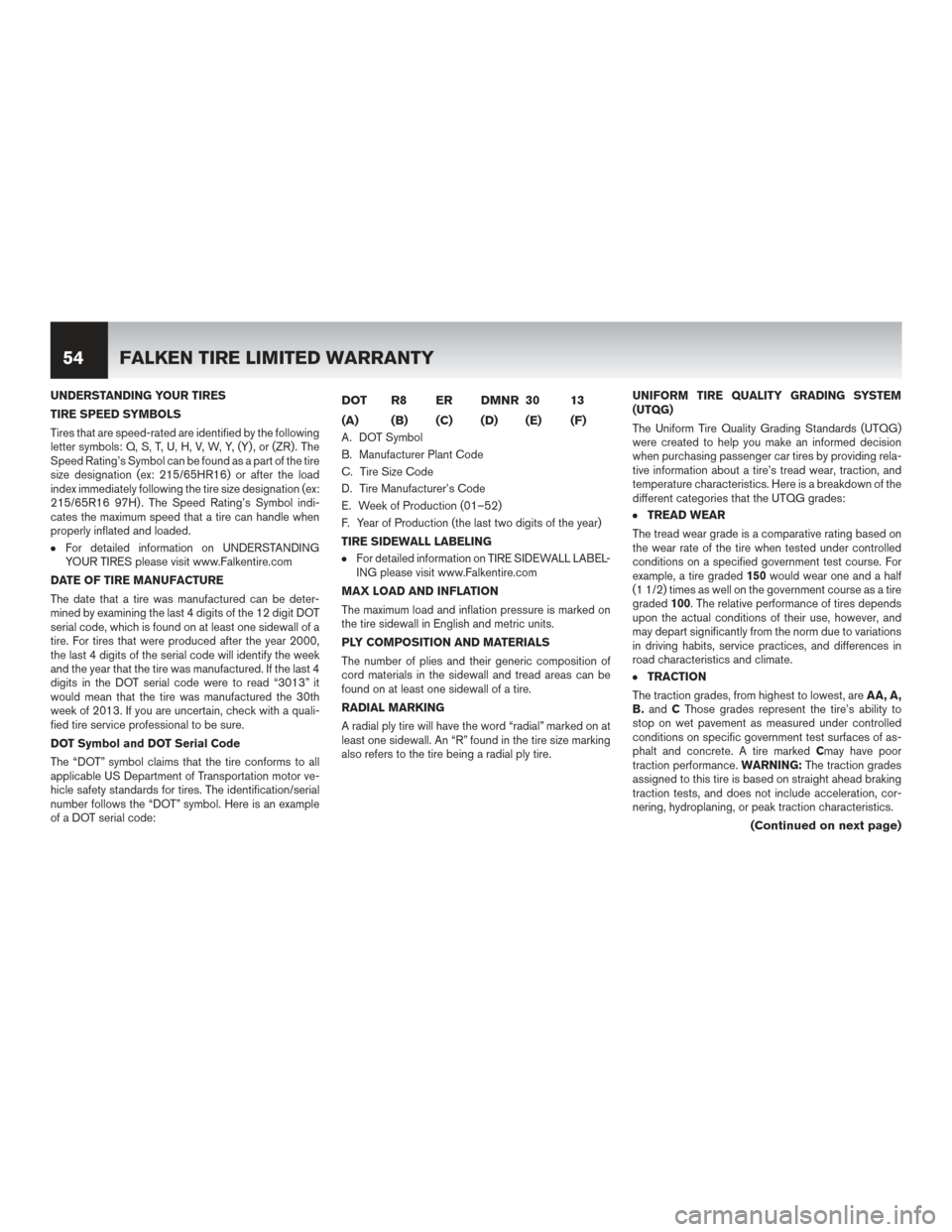
UNDERSTANDING YOUR TIRES
TIRE SPEED SYMBOLS
Tires that are speed-rated are identified by the following
letter symbols: Q, S, T, U, H, V, W, Y, (Y) , or (ZR) . The
Speed Rating’s Symbol can be found as a part of the tire
size designation (ex: 215/65HR16) or after the load
index immediately following the tire size designation (ex:
215/65R16 97H) . The Speed Rating’s Symbol indi-
cates the maximum speed that a tire can handle when
properly inflated and loaded.
●For detailed information on UNDERSTANDING
YOUR TIRES please visit www.Falkentire.com
DATE OF TIRE MANUFACTURE
The date that a tire was manufactured can be deter-
mined by examining the last 4 digits of the 12 digit DOT
serial code, which is found on at least one sidewall of a
tire. For tires that were produced after the year 2000,
the last 4 digits of the serial code will identify the week
and the year that the tire was manufactured. If the last 4
digits in the DOT serial code were to read “3013” it
would mean that the tire was manufactured the 30th
week of 2013. If you are uncertain, check with a quali-
fied tire service professional to be sure.
DOT Symbol and DOT Serial Code
The “DOT” symbol claims that the tire conforms to all
applicable US Department of Transportation motor ve-
hicle safety standards for tires. The identification/serial
number follows the “DOT” symbol. Here is an example
of a DOT serial code:
DOT R8 ER DMNR 30 13
(A) (B) (C) (D) (E) (F)
A. DOT Symbol
B. Manufacturer Plant Code
C. Tire Size Code
D. Tire Manufacturer’s Code
E. Week of Production (01–52)
F. Year of Production (the last two digits of the year)
TIRE SIDEWALL LABELING
●For detailed information on TIRE SIDEWALL LABEL-
ING please visit www.Falkentire.com
MAX LOAD AND INFLATION
The maximum load and inflation pressure is marked on
the tire sidewall in English and metric units.
PLY COMPOSITION AND MATERIALS
The number of plies and their generic composition of
cord materials in the sidewall and tread areas can be
found on at least one sidewall of a tire.
RADIAL MARKING
A radial ply tire will have the word “radial” marked on at
least one sidewall. An “R” found in the tire size marking
also refers to the tire being a radial ply tire. UNIFORM TIRE QUALITY GRADING SYSTEM
(UTQG)
The Uniform Tire Quality Grading Standards (UTQG)
were created to help you make an informed decision
when purchasing passenger car tires by providing rela-
tive information about a tire’s tread wear, traction, and
temperature characteristics. Here is a breakdown of the
different categories that the UTQG grades:
●TREAD WEAR
The tread wear grade is a comparative rating based on
the wear rate of the tire when tested under controlled
conditions on a specified government test course. For
example, a tire graded 150would wear one and a half
(1 1/2) times as well on the government course as a tire
graded 100. The relative performance of tires depends
upon the actual conditions of their use, however, and
may depart significantly from the norm due to variations
in driving habits, service practices, and differences in
road characteristics and climate.
●TRACTION
The traction grades, from highest to lowest, are AA, A,
B. and CThose grades represent the tire’s ability to
stop on wet pavement as measured under controlled
conditions on specific government test surfaces of as-
phalt and concrete. A tire marked Cmay have poor
traction performance. WARNING:The traction grades
assigned to this tire is based on straight ahead braking
traction tests, and does not include acceleration, cor-
nering, hydroplaning, or peak traction characteristics.
(Continued on next page)
54 FALKEN TIRE LIMITED WARRANTY
Page 60 of 97
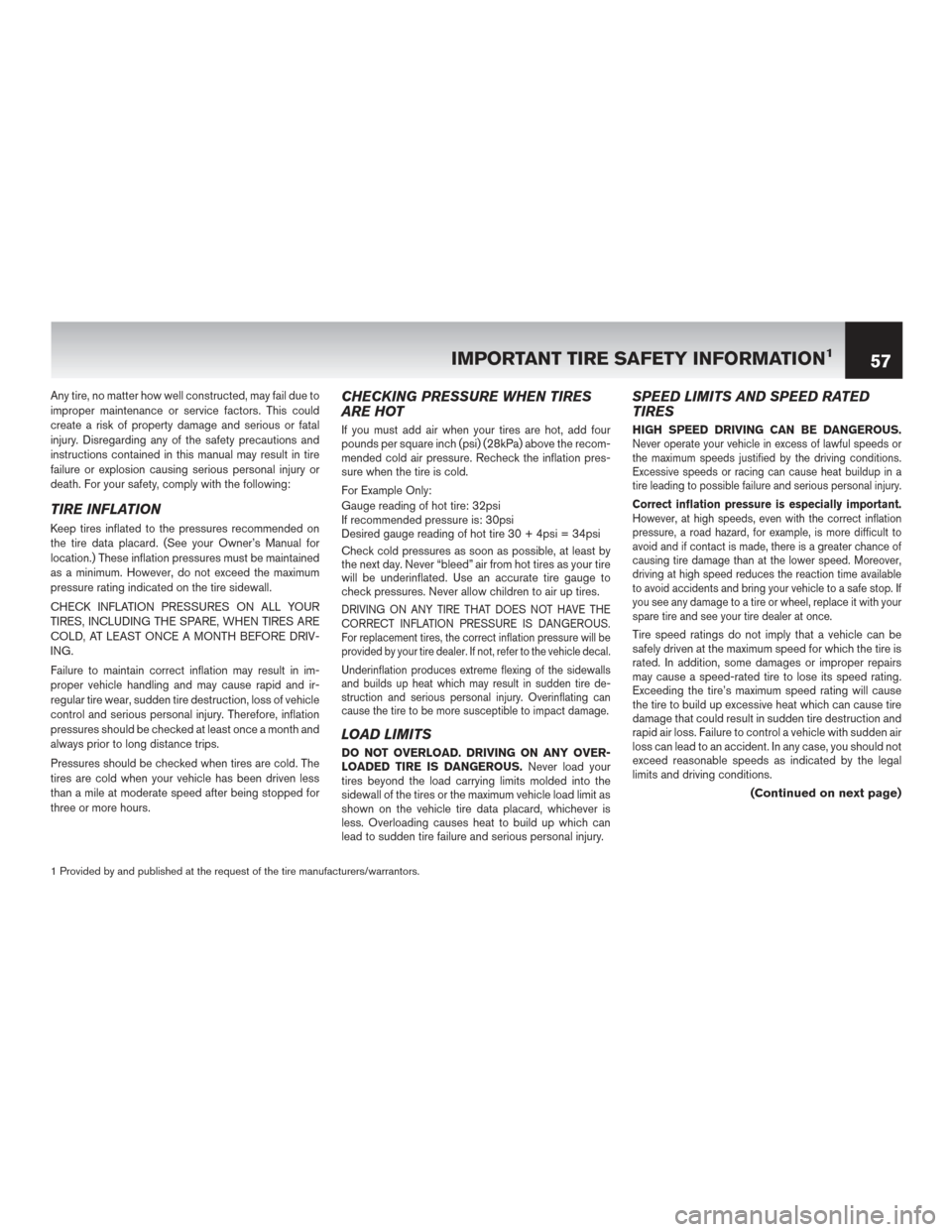
Any tire, no matter how well constructed, may fail due to
improper maintenance or service factors. This could
create a risk of property damage and serious or fatal
injury. Disregarding any of the safety precautions and
instructions contained in this manual may result in tire
failure or explosion causing serious personal injury or
death. For your safety, comply with the following:
TIRE INFLATION
Keep tires inflated to the pressures recommended on
the tire data placard. (See your Owner’s Manual for
location.) These inflation pressures must be maintained
as a minimum. However, do not exceed the maximum
pressure rating indicated on the tire sidewall.
CHECK INFLATION PRESSURES ON ALL YOUR
TIRES, INCLUDING THE SPARE, WHEN TIRES ARE
COLD, AT LEAST ONCE A MONTH BEFORE DRIV-
ING.
Failure to maintain correct inflation may result in im-
proper vehicle handling and may cause rapid and ir-
regular tire wear, sudden tire destruction, loss of vehicle
control and serious personal injury. Therefore, inflation
pressures should be checked at least once a month and
always prior to long distance trips.
Pressures should be checked when tires are cold. The
tires are cold when your vehicle has been driven less
than a mile at moderate speed after being stopped for
three or more hours.
CHECKING PRESSURE WHEN TIRES
ARE HOT
If you must add air when your tires are hot, add four
pounds per square inch (psi) (28kPa) above the recom-
mended cold air pressure. Recheck the inflation pres-
sure when the tire is cold.
For Example Only:
Gauge reading of hot tire: 32psi
If recommended pressure is: 30psi
Desired gauge reading of hot tire 30 + 4psi = 34psi
Check cold pressures as soon as possible, at least by
the next day. Never “bleed” air from hot tires as your tire
will be underinflated. Use an accurate tire gauge to
check pressures. Never allow children to air up tires.
DRIVING ON ANY TIRE THAT DOES NOT HAVE THE
CORRECT INFLATION PRESSURE IS DANGEROUS.
For replacement tires, the correct inflation pressure will be
provided by your tire dealer. If not, refer to the vehicle decal.
Underinflation produces extreme flexing of the sidewalls
and builds up heat which may result in sudden tire de-
struction and serious personal injury. Overinflating can
cause the tire to be more susceptible to impact damage.
LOAD LIMITS
DO NOT OVERLOAD. DRIVING ON ANY OVER-
LOADED TIRE IS DANGEROUS.Never load your
tires beyond the load carrying limits molded into the
sidewall of the tires or the maximum vehicle load limit as
shown on the vehicle tire data placard, whichever is
less. Overloading causes heat to build up which can
lead to sudden tire failure and serious personal injury.
SPEED LIMITS AND SPEED RATED
TIRES
HIGH SPEED DRIVING CAN BE DANGEROUS.Never operate your vehicle in excess of lawful speeds or
the maximum speeds justified by the driving conditions.
Excessive speeds or racing can cause heat buildup in a
tire leading to possible failure and serious personal injury.
Correct inflation pressure is especially important.
However, at high speeds, even with the correct inflation
pressure, a road hazard, for example, is more difficult to
avoid and if contact is made, there is a greater chance of
causing tire damage than at the lower speed. Moreover,
driving at high speed reduces the reaction time available
to avoid accidents and bring your vehicle to a safe stop. If
you see any damage to a tire or wheel, replace it with your
spare tire and see your tire dealer at once.
Tire speed ratings do not imply that a vehicle can be
safely driven at the maximum speed for which the tire is
rated. In addition, some damages or improper repairs
may cause a speed-rated tire to lose its speed rating.
Exceeding the tire’s maximum speed rating will cause
the tire to build up excessive heat which can cause tire
damage that could result in sudden tire destruction and
rapid air loss. Failure to control a vehicle with sudden air
loss can lead to an accident. In any case, you should not
exceed reasonable speeds as indicated by the legal
limits and driving conditions.
(Continued on next page)
1 Provided by and published at the request of the tire manufacturers/warrantors.
IMPORTANT TIRE SAFETY INFORMATION157
Page 61 of 97
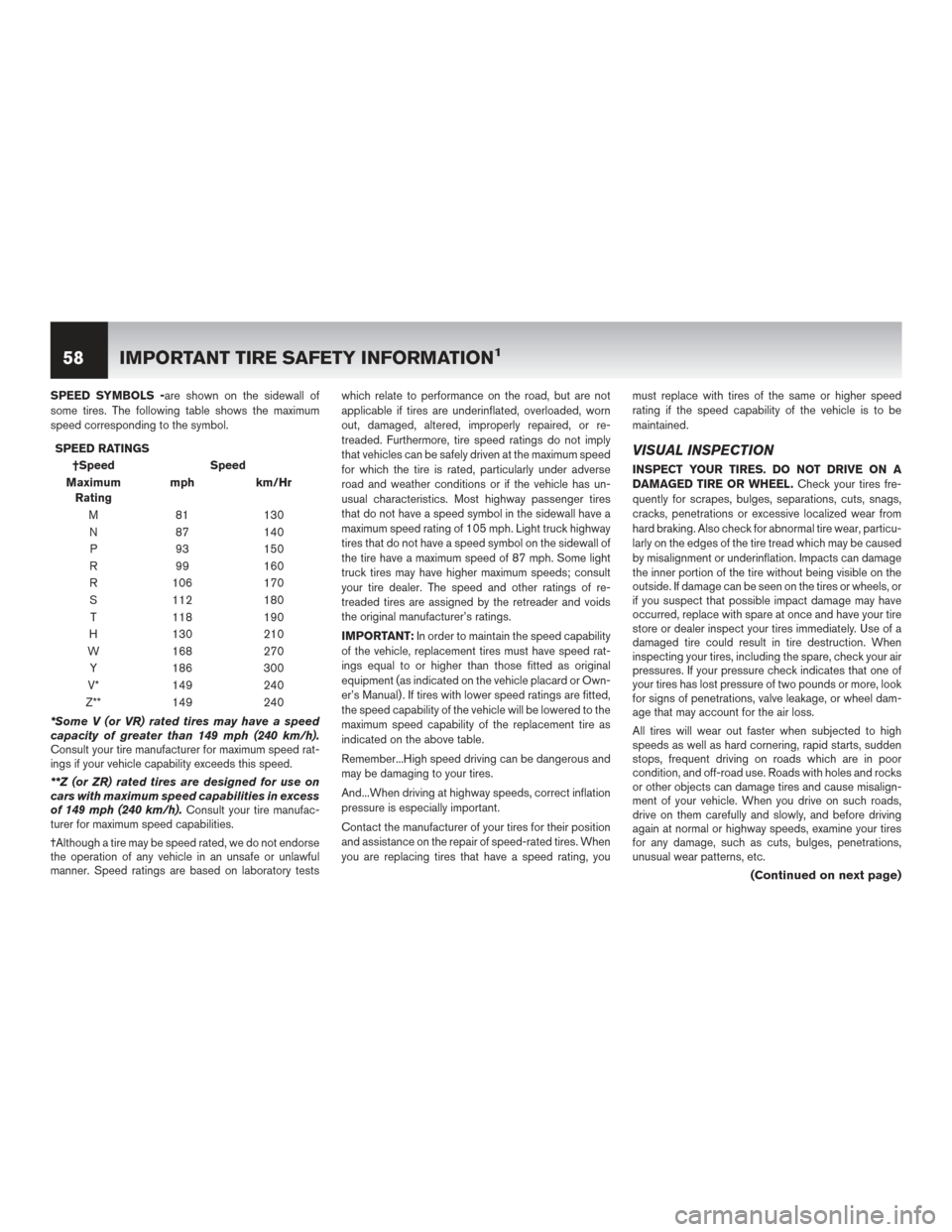
SPEED SYMBOLS -are shown on the sidewall of
some tires. The following table shows the maximum
speed corresponding to the symbol.SPEED RATINGS †Speed Speed
Maximum Rating mph km/Hr
M 81 130
N 87 140
P 93 150
R 99 160
R 106 170
S 112 180
T 118 190
H 130 210
W 168 270
Y 186 300
V* 149 240
Z** 149 240
*Some V (or VR) rated tires may have a speed
capacity of greater than 149 mph (240 km/h).
Consult your tire manufacturer for maximum speed rat-
ings if your vehicle capability exceeds this speed.
**Z (or ZR) rated tires are designed for use on
cars with maximum speed capabilities in excess
of 149 mph (240 km/h). Consult your tire manufac-
turer for maximum speed capabilities.
†Although a tire may be speed rated, we do not endorse
the operation of any vehicle in an unsafe or unlawful
manner. Speed ratings are based on laboratory tests which relate to performance on the road, but are not
applicable if tires are underinflated, overloaded, worn
out, damaged, altered, improperly repaired, or re-
treaded. Furthermore, tire speed ratings do not imply
that vehicles can be safely driven at the maximum speed
for which the tire is rated, particularly under adverse
road and weather conditions or if the vehicle has un-
usual characteristics. Most highway passenger tires
that do not have a speed symbol in the sidewall have a
maximum speed rating of 105 mph. Light truck highway
tires that do not have a speed symbol on the sidewall of
the tire have a maximum speed of 87 mph. Some light
truck tires may have higher maximum speeds; consult
your tire dealer. The speed and other ratings of re-
treaded tires are assigned by the retreader and voids
the original manufacturer’s ratings.
IMPORTANT:
In order to maintain the speed capability
of the vehicle, replacement tires must have speed rat-
ings equal to or higher than those fitted as original
equipment (as indicated on the vehicle placard or Own-
er’s Manual) . If tires with lower speed ratings are fitted,
the speed capability of the vehicle will be lowered to the
maximum speed capability of the replacement tire as
indicated on the above table.
Remember...High speed driving can be dangerous and
may be damaging to your tires.
And...When driving at highway speeds, correct inflation
pressure is especially important.
Contact the manufacturer of your tires for their position
and assistance on the repair of speed-rated tires. When
you are replacing tires that have a speed rating, you must replace with tires of the same or higher speed
rating if the speed capability of the vehicle is to be
maintained.
VISUAL INSPECTION
INSPECT YOUR TIRES. DO NOT DRIVE ON A
DAMAGED TIRE OR WHEEL.
Check your tires fre-
quently for scrapes, bulges, separations, cuts, snags,
cracks, penetrations or excessive localized wear from
hard braking. Also check for abnormal tire wear, particu-
larly on the edges of the tire tread which may be caused
by misalignment or underinflation. Impacts can damage
the inner portion of the tire without being visible on the
outside. If damage can be seen on the tires or wheels, or
if you suspect that possible impact damage may have
occurred, replace with spare at once and have your tire
store or dealer inspect your tires immediately. Use of a
damaged tire could result in tire destruction. When
inspecting your tires, including the spare, check your air
pressures. If your pressure check indicates that one of
your tires has lost pressure of two pounds or more, look
for signs of penetrations, valve leakage, or wheel dam-
age that may account for the air loss.
All tires will wear out faster when subjected to high
speeds as well as hard cornering, rapid starts, sudden
stops, frequent driving on roads which are in poor
condition, and off-road use. Roads with holes and rocks
or other objects can damage tires and cause misalign-
ment of your vehicle. When you drive on such roads,
drive on them carefully and slowly, and before driving
again at normal or highway speeds, examine your tires
for any damage, such as cuts, bulges, penetrations,
unusual wear patterns, etc.
(Continued on next page)
58 IMPORTANT TIRE SAFETY INFORMATION1
Page 64 of 97
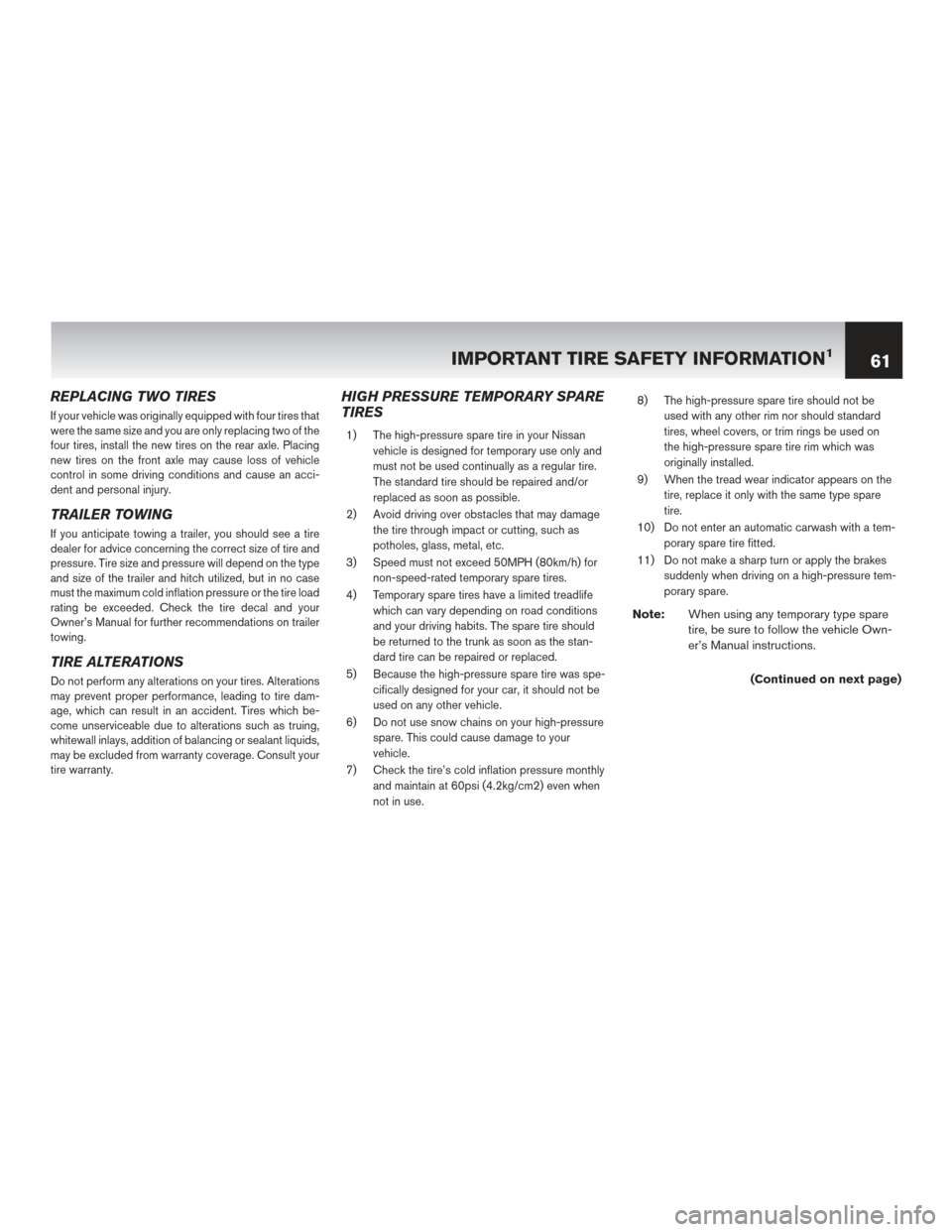
REPLACING TWO TIRES
If your vehicle was originally equipped with four tires that
were the same size and you are only replacing two of the
four tires, install the new tires on the rear axle. Placing
new tires on the front axle may cause loss of vehicle
control in some driving conditions and cause an acci-
dent and personal injury.
TRAILER TOWING
If you anticipate towing a trailer, you should see a tire
dealer for advice concerning the correct size of tire and
pressure. Tire size and pressure will depend on the type
and size of the trailer and hitch utilized, but in no case
must the maximum cold inflation pressure or the tire load
rating be exceeded. Check the tire decal and your
Owner’s Manual for further recommendations on trailer
towing.
TIRE ALTERATIONS
Do not perform any alterations on your tires. Alterations
may prevent proper performance, leading to tire dam-
age, which can result in an accident. Tires which be-
come unserviceable due to alterations such as truing,
whitewall inlays, addition of balancing or sealant liquids,
may be excluded from warranty coverage. Consult your
tire warranty.
HIGH PRESSURE TEMPORARY SPARE
TIRES
1) The high-pressure spare tire in your Nissanvehicle is designed for temporary use only and
must not be used continually as a regular tire.
The standard tire should be repaired and/or
replaced as soon as possible.
2) Avoid driving over obstacles that may damage the tire through impact or cutting, such as
potholes, glass, metal, etc.
3) Speed must not exceed 50MPH (80km/h) for non-speed-rated temporary spare tires.
4) Temporary spare tires have a limited treadlife which can vary depending on road conditions
and your driving habits. The spare tire should
be returned to the trunk as soon as the stan-
dard tire can be repaired or replaced.
5) Because the high-pressure spare tire was spe- cifically designed for your car, it should not be
used on any other vehicle.
6) Do not use snow chains on your high-pressure spare. This could cause damage to your
vehicle.
7) Check the tire’s cold inflation pressure monthly and maintain at 60psi (4.2kg/cm2) even when
not in use. 8) The high-pressure spare tire should not be
used with any other rim nor should standard
tires, wheel covers, or trim rings be used on
the high-pressure spare tire rim which was
originally installed.
9) When the tread wear indicator appears on the tire, replace it only with the same type spare
tire.
10) Do not enter an automatic carwash with a tem- porary spare tire fitted.
11) Do not make a sharp turn or apply the brakes suddenly when driving on a high-pressure tem-
porary spare.
Note: When using any temporary type spare
tire, be sure to follow the vehicle Own-
er’s Manual instructions.
(Continued on next page)
IMPORTANT TIRE SAFETY INFORMATION161
Page 65 of 97
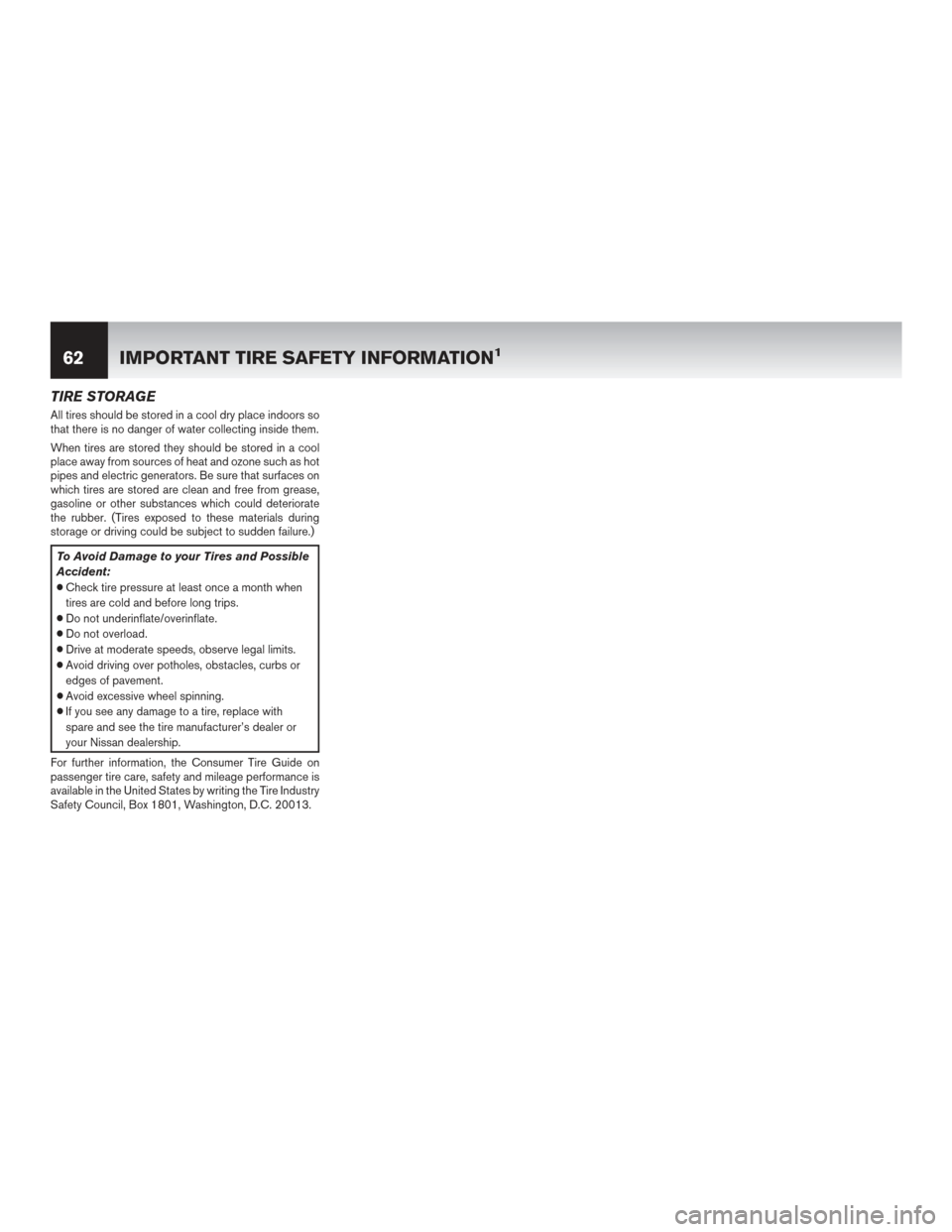
TIRE STORAGE
All tires should be stored in a cool dry place indoors so
that there is no danger of water collecting inside them.
When tires are stored they should be stored in a cool
place away from sources of heat and ozone such as hot
pipes and electric generators. Be sure that surfaces on
which tires are stored are clean and free from grease,
gasoline or other substances which could deteriorate
the rubber. (Tires exposed to these materials during
storage or driving could be subject to sudden failure.)
To Avoid Damage to your Tires and Possible
Accident:
●Check tire pressure at least once a month when
tires are cold and before long trips.
● Do not underinflate/overinflate.
● Do not overload.
● Drive at moderate speeds, observe legal limits.
● Avoid driving over potholes, obstacles, curbs or
edges of pavement.
● Avoid excessive wheel spinning.
● If you see any damage to a tire, replace with
spare and see the tire manufacturer’s dealer or
your Nissan dealership.
For further information, the Consumer Tire Guide on
passenger tire care, safety and mileage performance is
available in the United States by writing the Tire Industry
Safety Council, Box 1801, Washington, D.C. 20013.
62 IMPORTANT TIRE SAFETY INFORMATION1